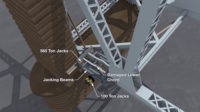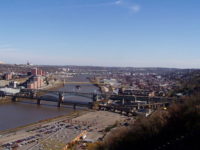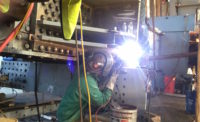Nearly two years after a fire closed Pittsburgh's Liberty Bridge for 24 days in September 2016, the approximately $81-million rehabilitation project is almost complete—and only about a month over schedule.
While contractor Joseph B. Fay Co. made up lost time caused by the fire, the project originally slated to be finished on July 30 is now set to be completed on Aug. 26. The Pennsylvania Dept. of Transportation recently gave Fay more time to deliver the project after the agency asked the contractor to install extra items that weren't part of the project's initial scope.
Those items included fiberglass bird screens to protect the bridge's box chords across three spans totaling 664 ft in length. PennDOT also asked Fay to seal the bridge's sidewalk. The added items, along with change orders during the course of the project, have so far increased the project's cost by approximately $1.8 million, according Doug Thompson, a principal assistant construction engineer at PennDOT. Thompson said that figure includes unforeseen steel repairs to the boulevard of the Allies Bridge, which feeds into the Liberty Bridge.
Fay's spokeswoman, Katie Spear, referred all questions to PennDOT.
The 90-year-old bridge's first rehabilitation since 1982 began in August 2015. The project has involved structural steel repairs as well as bridge deck replacement, ramp reconstruction, painting, concrete repairs, signage improvements and a new alternating overhead lane control system. The 2,663-ft-long steel cantilever bridge has a main span length of 470 ft and a water clearance height of 60 ft. About 55,000 vehicles cross it each day.
About one year into the project, fire damaged 30 ft of chord truss subject to substantial loads. Crews worked nonstop for weeks to fix the damage. The work required jacking and localized heating to straighten the chord and redistribute the load on the bridge. A temporary 9-ton weight limit was placed on the bridge, while crews added steel to strengthen the truss chord.
The fire was caused by a welder that accidentally ignited tarps and plastic pipe. Fay was charged $213,000 in liquidated damages for every weekday and $72,000 for every weekend the bridge was closed.
But a settlement reached with PennDOT in May 2017 allowed Fay to avoid paying $3 million in liquidated damages by adjusting the project's schedule to include fewer bridge and lane closures. "As part of the settlement agreement they accelerated and reduced the durations of the lane and road and ramp closures during the 2017 season," Thompson says, "and they offset all of those road user costs that were incurred during the 2016 fire closure."
Thompson says Fay did pay about $5 million for emergency repairs and that the firm's insurance company is reimbursing PennDOT just under $1 million for the agency's repair-related expenses. "I'm sure their insurance company is reimbursing them for a portion of their costs too," Thompson says.
An initial $11,224 penalty issued by the Occupational Safety and Health Administration for not adhering to appropriate fire safety practices was also reduced to $7,500 after an "informal settlement," according to OSHA spokeswoman Joanna Hawkins, despite the fact that two minor fires occurred during the project before the massive fire that closed the bridge in September 2016.
Despite all the project's "challenges," Thompson says "both parties are very happy with the outcome of the project," especially given the fact that there will be "no claims, no disputes and no potential litigation." Thompson says, "Hopefully the public will be happy here shortly when we have a nice smooth ride across the bridge, and a nice freshly painted structure as well."






Post a comment to this article
Report Abusive Comment